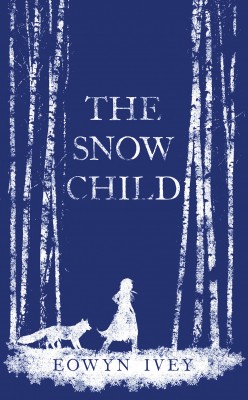The mystery that shape-shifted at the edge of her senses

The Snow Child
by Eowyn Ivey
This book was almost ruined for me by Book at Bedtime. The thing is, I love that Book at Bedtime exists, I do, but when a full-length novel is compressed into 10 15-minute segments, then necessarily a lot is cut out. A lot. (For comparison, the unabridged audio book of this is almost 11 hours.) I listened to The Snow Child on Book at Bedtime and thought ‘Huh. I don’t get the hype at all.’ And that was very nearly that.
I had read so many glowing reviews by fellow bloggers I usually share a taste in books with that I kept thinking that maybe I would give it another chance. Maybe. But I didn’t add it to my wishlist. So thank goodness I spotted it in a bookswap and decided to pick it up. From page one I was captivated.
“All her life she had believed in something more, in the mystery that shape-shifted at the edge of her senses. It was the flutter of moth wings on glass and the promise of river nymphs in the dappled creek beds. It was the smell of oak trees on the summer evening she fell in love, and the way dawn threw itself across a cow pond and turned the water to light.”
The story is adapted from the old Russian fairy tale “Snegurochka” and cleverly acknowledges this. Jack and Mabel are in their older middle age when they move to Alaska in the 1920s, looking for a fresh start. They cannot forget the sadness caused by their inability to have children and their marriage is fragile. Will the harshness of farming in Alaska heal them or break them?
“Words lay like granite boulders in her lap and when at last she spoke, each one was heavy and burdensome and all she could manage.”
The book opens at the start of their second Alaskan winter. Mabel is about ready to give up, Jack is seriously considering taking a very dangerous mining job that would take him away for most of the winter. Then the first snow falls and in a bittersweet scene of childlike play, the couple build a snowgirl. In the morning their snowgirl is gone and child-sized footsteps lead away from it. Are they just misreading the tracks in the snow? Did their snowgirl just get knocked down by a fox or other wild creature?
Perhaps, but at about that time they start seeing a small girl near their home, usually accompanied by a red fox, just like in the storybook Mabel remembers loving as a child, and she becomes convinced that they brought the girl to life with their desperate longing. The girl, Faina, slowly becomes a part of their lives. But is she real? Or is she, as Jack and Mabel’s (distant) neighbours George and Esther believe, a figment of their imaginations, a coping mechanism through the long lonely winter?
I like that the book provides realistic as well as magical explanations for everything that happens and never makes one more likely than the other. There is a definite fairytale feeling to the writing and yet it doesn’t shy away from the harshness of the Alaskan environment. Without ever getting repetitive or depressing, Ivey makes the cold and darkness of winter ever-present. But she also displays great love and respect for Alaska that I found enticing.
“A red fox darted among the fallen trees. It disappeared for a minute but popped up again, closer to the forest, running with its fluffy tail held low to the ground. It stopped and turned its head. For a moment its eyes locked with Jack’s, and there, in its narrowing golden irises, he saw the savagery of the place. Like he was staring wilderness itself straight in the eye.”
Just as I already knew the storyline before reading the book (which didn’t spoil it at all for me, though I’m still going to hold back from revealing any more of the story in this review) I also already knew, thanks to various reviews I’d read and an interview with Eowyn Ivey on The Readers, that whenever Faina speaks there are no speechmarks, for her or for the person speaking directly to her. But there are speechmarks everywhere else. This is a really clever way of maintaining the mystery, especially in the brief sections where it seems like maybe everything has been neatly explained.
Really, it’s a very simple story. And anyone who has read any of the versions of the old fairy tale (the Arthur Ransome version is included in my copy of the book, which I thought a nice touch) could have a fair stab at how it will turn out. But, for me at least, this book was about the language. Despite being hooked I read it quite slowly because it was the kind of language that slows you down, makes you want to take in each sentence. Exquisite.
Published 2012 by Headline.
Source: A book swap.
See also: reviews by Simon of Savidge Reads and Ellie of Curiosity Killed the Bookworm.